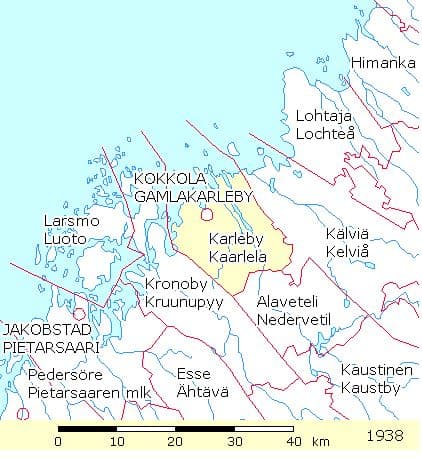Ostrobothnia
Karleby
Parish History
- Karleby originally was a part of the large Pedersöre parish
- In about 1467 Karleby had its own chapel, but it was still under the Pedersöre Parish
- It became an independent parish between 1494 and 1511
The City of Gamlakarleby
Gamlakarleby was one of 15 cities that King Gustav II Adolf of Sweden founded. The foundation letter is dated September 7, 1620. 2,7 Preserved historical documents indicate the village was in existence in 1375. 3 The City of Gamlakarleby kept separate parish records from the rural villages of the Karleby parish. In the 1970’s, the city officially changed its name to Karleby.
Parish Records
Villages and farms of Karleby were recorded in T.W. Karsten’s work, Svesk Bygd I Osterbotten: Nu Och Fordom. 6 Karleby Parish Communion records were not used to confirm these findings. Because parish Communion records are listed by village and farm name and because farm names often were used as a part of a person’s name, it is interesting to note the following farms.
To open a printable list of villages and farms (pdf), click here.
Historic Villages
The historic villages in the Karleby parish were:
- Kallis
- Kirilax
- Korplax
- Kvinkant
- Kåustar
- Linnusperä
- Närvillä
- Palo
- Rödsö
- Storby
- Såka
- Vittsar
- Åivu
Farms
- Kallis
- Åsmus
- Nygård
- Ventus
- Brink
- Villa
- Prästgården
- Reipsar
- Kåla
- Lillkåla
- Gunnars
- Kauko
- Vitick
- Korpi
- Kotkamaa
- Hassinen
- Räbb
- Huhta
- Hiekkilä
- Räihä
- Präst
- Kotka
- Hautonen
- Hilli
- Kourujärvi
- Runtujärvi
- Kvikant
- Mellangård
- Nygrann
- Suomalaks
- Kåustar
- Tylli
- Jubbila
- Korp
- Varg
- Måsala
- Lillmåsala
- Kyrkr
- Gråssi
- Domars
- Stormåsala
- Indola
- Vevar
- Brandt
- Stor
- Alskog
- Pulkis
- Saari
- Nygård
- Hakalax
- Måttis
- Heinola
- Vidnäs
- Savelä
- Haukilaks
- Borg
- Puntus
- Biskop
- Viken
- Lytts
- Lussi
- Strang
- Kuli
- Härmälä
- Kankkonen
- Silakka
- Lidsle
- Harald
- Väster
- Bredskär
- Nabbala
- Kiviniemi
- Sipola
- Hannila
- Broända
- Juvala
- Nynäs
- Finnilä
- Lågland
- Rakså
- Klockars
- Rasmus
- Ventjärvi
- Björndal
- Tuomisalo
- Hällis
- Notjärvi
- Skrabb
- Kulla
- Hals
- Björk
- Porko
- Bäck
- Furubacka
- Honga
- Lillhonga
- Masas
- Vässi
- Visur
- Fordel
- Nissant
- Åivu
- Lillåivu
- Högbacka
Of Interest
The Skirmish of Halkokari
“On June 6, 1854 during the Crimean War, Royal Marines from HMS Vulture and HMS Odin tried to come ashore to deal with public property in town ‘in accordance with the usage of war’. The marines were repelled by local defenders armed with hunting rifles supported by troops, artillery and possible Russian advisors and military. One of the nine smaller British craft fell into the hands of the defenders. This boat was the only Royal Navy vessel still in foreign possession in 1914. The boat is today still a museum-object and can be seen in Kokkola’s English Park.” 7
To watch a video on the ‘Skirmish of Halkokari’, click here.
Karleby Images
To view more images of Karleby, click here.
A town with a tale to tell
Watch an interview of author Lars Strang, who tells about his findings of life in Gamlekarleby in the mid-1600’s. Click here to begin (skip ads to go straight to the interview).
References
- Genealogical Society of Finland, HisKi project, Karleby parish, http://hiski.genealogia.fi/hiski/a3dlaw?en+0172
- History of Kokkola, https://www.kokkola.fi/kokkola_tietoa/historia/en_GB/historia/
- Kaarlela church image, https://commons.wikimedia.org/wiki/File:Kaarlelan_kirkko_C_IMG_9822.JPG
- Karleby Medieval church; http://sydaby.eget.net/swe/jp_kc.htm
- Karleby, https://sv.wikipedia.org/wiki/Karleby
- Karsten T.W., Svesk Bygd I Osterbotten: Nu Och Fordom; Helingfors, 1923, pages 216 – 219
- Kokkola, https://en.wikipedia.org/wiki/Kokkola
- Karleby Folk Dress image, Brage costume agency, https://www.brage.fi/sve/draktbyra/draktbyran/folkdrakter/view-163648-71




